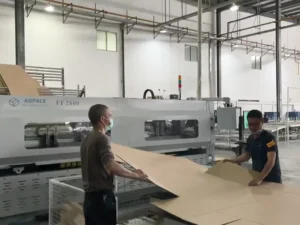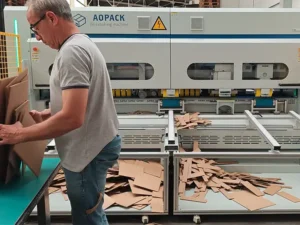Creating your own corrugated cardboard box is a practical and cost-effective way to customize packaging for shipping, storage, or creative projects. Whether you need a specific size or want to repurpose materials, this guide will walk you through the process of crafting a sturdy box from scratch.
Materials and Tools You’ll Need
– Corrugated cardboard sheets: Choose single-wall (one layer of fluting) for lightweight items or double-wall (two layers) for heavier objects.
– Ruler or measuring tape
– Pencil or marker
– Utility knife or box cutter
– Straightedge (metal ruler or sturdy straight object)
– Strong adhesive (craft glue, hot glue gun, or packing tape)
– Cutting mat (optional but recommended for safety)
Step 1: Determine Box Dimensions
Start by calculating the required dimensions:
– Length (L): The longest side of the item you’re boxing.
– Width (W): The shorter side.
– Height (H): The depth of the box.
Add 1–2 inches to each measurement to allow space for padding. For example, if your item is 10″ long, make the box 12″ long.
Step 2: Sketch the Box Template
Corrugated boxes are made from a single sheet of cardboard folded into shape. Draw the template as follows:
1. Base: Draw a rectangle measuring Length × Width.
2. Sides: Extend flaps from each side of the base equal to the box’s height (H). For example:
– Two flaps of height H on the length sides.
– Two flaps of height H on the width sides.
3. Top flaps: Add an extra 1–2 inches to one pair of opposing side flaps to create overlapping closures.
Ensure the corrugation lines (ridges) run vertically for maximum strength when folded.
Step 3: Cut the Template
Place the cardboard on a cutting mat. Use a utility knife and straightedge to cut along your drawn lines. Apply firm, even pressure to avoid jagged edges. Remove excess material carefully.
Step 4: Score the Folding Lines
To ensure clean folds, lightly score along the edges where the flaps meet the base. Run the utility knife along a straightedge, cutting only through the top layer of cardboard. Avoid cutting all the way through—this creates a hinge for folding.
Step 5: Assemble the Box
1. Fold the sides upward: Bend the scored flaps to form the box walls. The corrugation should face outward for rigidity.
2. Secure the corners: Apply adhesive to the inner edges where the side flaps meet. Press firmly and hold for 30 seconds. For extra strength, reinforce corners with packing tape.
3. Attach the bottom flaps: Fold the shorter flaps inward, apply adhesive, and press them onto the base. Overlap the longer flaps over them and glue.
Step 6: Create the Lid (Optional)
For a lidded box, repeat Steps 1–5 but increase the height by 0.5 inches to ensure a snug fit. Alternatively, extend the top flaps of the original box and score them to fold inward.
Pro Tips for Success
– Reinforce stress points: Add extra glue or tape to corners and seams.
– Customize with cushioning: Line the box with bubble wrap or crumpled paper.
– Test durability: Load the box with a heavy item before trusting it for shipping.
Why DIY?
DIY boxes save money, reduce waste by repurposing old cardboard, and allow tailor-made solutions for oddly shaped items. With practice, you can create boxes for books, gifts, or even furniture moving. Remember to wear protective gloves when cutting cardboard to avoid paper cuts!
By mastering this skill, you’ll gain a versatile packaging solution that’s both eco-friendly and adaptable to your needs. Happy crafting!
How useful was this post?
Click on a star to rate it!
Average rating 0 / 5. Vote count: 0
No votes so far! Be the first to rate this post.







